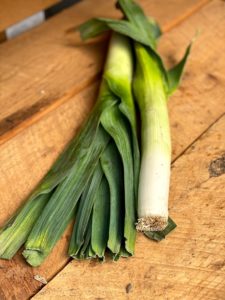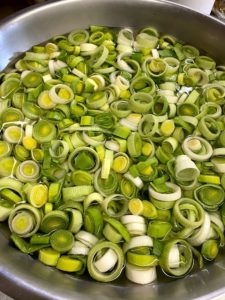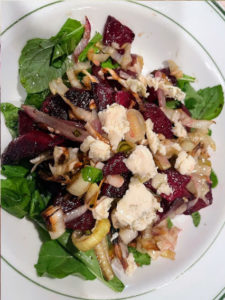Geek over Leeks
Geek over Leeks
Leeks are in the allium family related to onions, garlic, chives, shallots, ramps and scallions. One taste and you will be able to tell that very easily. Leeks have a sweet, milder onion flavor that works so well as a base for soups, stews, pasta dishes. It’s a long bulbous vegetable with white flesh and… Read More »

High in polyphenols, foods from the allium family are believed to improve cardiovascular health and reduce inflammation. High in Vitamins A, K along with B-6, folate, iron, calcium and manganese, leeks are low in calories and so easy to use. Give them a try today with this Roasted Beet & Leek recipe provided by our culinary & educational specialist, Miss Jenn.
Leek season at the farm is typically early Spring, late into summer and again through the fall. The first planting of leek seeds is planted in the greenhouse when onions are started typically around March and then there is a second planting in the greenhouse after that. The seeds are not directly planted in the ground as they are slow to germinate and are more successful starting in the greenhouse. We plant seeds in the previous spring to use for the next season so they are planting now for spring 2023. Some will be harvested in the late fall and some overwintered, meaning they will stay in the ground through Winter. We use row cover for extreme temps and rely on the snow to help insulate the crop. In the early spring the leek crop can look as though they are not alive and then they gradually become more green and toughen up. Wintered over leeks may have some brown soft leaves that are removed before selling, the frost is said to improve their flavor as the cold causes the starches present in its stem and leaves to change into sugars. Typically, the final leek harvest used to be at the end of November which coincides with using leeks at Thanksgiving time however we have been able to push the harvest date well into December. We harvest our spring leeks before the temperatures warm up or they may start to bloom which makes them less palatable. There are also leek varieties that are bred for harvest in the summer, helping us make leeks available year-round.
Leeks have a longer shelf life and are stored properly in your refrigerator. The trick is to not wash them before storing. Keep in a closed bag to avoid other foods absorbing flavors. They should stay
We hope you enjoy eating in season with us on our farm and are adventurous to try a few of these recipes in season.
Best wishes from our farm kitchen to yours! xo








